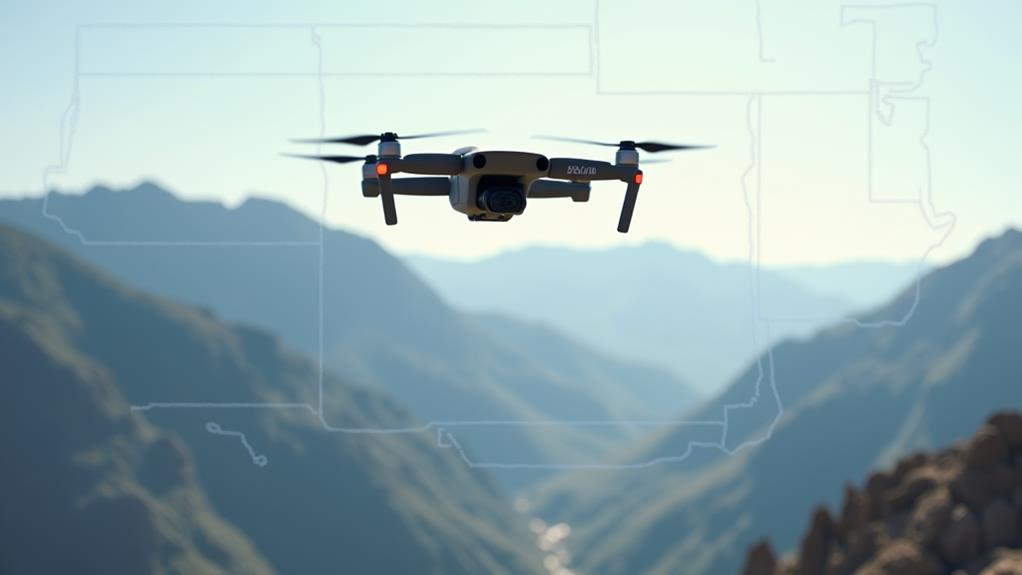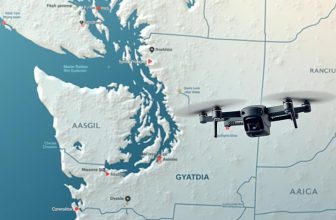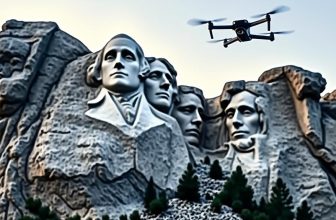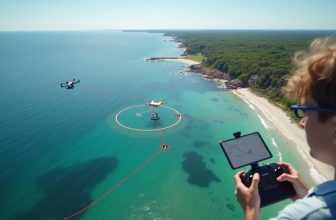
You're considering flying a drone in Utah, but before you take to the skies, crucially, you must understand the state's drone laws. If you're operating a drone that weighs between 0.55 and 55 pounds, you'll need to register it with the FAA for a $5 fee that's valid for three years. But that's just the beginning – Utah has specific regulations for recreational and commercial pilots, including age requirements and certifications. What you might not know, however, are the nuances of flying over private property and the severe penalties for violating these laws – are you prepared to take the risk?
Contents
- 1 Key Takeaways
- 2 Utah Drone Registration Requirements
- 3 Recreational Drone Flying Rules
- 4 Commercial Drone Regulations
- 5 Drone Airspace Restrictions
- 6 Private Property Drone Laws
- 7 Drone Pilot License Requirements
- 8 Utah No Drone Zones
- 9 Drone Insurance Requirements
- 10 Penalties for Drone Law Violations
- 11 Frequently Asked Questions
- 12 Conclusion
Key Takeaways
- Recreational drone pilots in Utah must register drones weighing between 0.55 lbs and 55 lbs with the FAA.
- Commercial drone pilots in Utah need a Remote Pilot Certificate with a Small Unmanned Aircraft Systems (sUAS) rating.
- Utah law prohibits flying drones over private property without permission, and aerial surveillance is considered an invasion of privacy.
- No-fly zones in Utah include national parks, military bases, airports, prisons, and areas with temporary airspace restrictions.
- Violating Utah's drone laws can result in significant fines, jail time, and civil liability, with penalties ranging from a few hundred dollars to thousands of dollars.
Utah Drone Registration Requirements
You'll also need to provide your drone's make, model, and serial number. A $5 registration fee is required, and your registration will be valid for three years. Once registered, you'll receive a unique registration number that you must display on your drone.
As a drone owner, it's crucial to understand the registration requirements to avoid fines and penalties.
Failure to register your drone can result in fines up to $27,500. Additionally, flying an unregistered drone can lead to flying restrictions and even confiscation of your drone.
Recreational Drone Flying Rules
As you prepare to fly your drone recreationally in Utah, you'll need to be aware of specific rules governing age and skill level, as well as drone weight limits.
You must be at least 13 years old to operate a recreational drone, or be directly supervised by someone who's at least 13 if you're younger.
Additionally, you'll need to verify your drone weighs no more than 55 pounds, and you'll have to avoid no-fly zones, such as national parks and restricted airspace.
Age and Skill Level
Recreational drone pilots in Utah must be at least 13 years old to fly a drone without adult supervision. However, children under 13 can still fly a drone, but they must be under the direct supervision of a person who's at least 18 years old and has the required knowledge and skills to operate the drone safely.
If you're new to drone flying, it's recommended that you undergo youth training or online tutorials to learn the basics of drone operation and safety guidelines.
This training will help you develop the necessary skills to fly a drone safely and responsibly.
As an experienced operator, you'll be expected to follow the same safety guidelines and regulations as new pilots, but you may be able to skip some of the basic training.
It's crucial to stay current with the latest regulations and best practices in drone flying to guarantee a safe and enjoyable experience for yourself and others.
Drone Weight Limits
The Federal Aviation Administration (FAA) sets drone weight limits for recreational drone flying in Utah, categorizing drones based on their maximum takeoff weight.
You should be aware that drones are divided into different weight classes, which determine the regulations you must follow to guarantee drone safety.
For drones weighing less than 0.55 pounds (250g), you're exempt from registration requirements. However, you're still required to follow the FAA's recreational drone flying rules.
Drones weighing between 0.55 pounds (250g) and 3.3 pounds (1.5kg) must be registered with the FAA, and you'll need to label your drone with your registration number.
Drones weighing more than 3.3 pounds (1.5kg) but less than 55 pounds (25kg) also require registration and labeling.
Additionally, you'll need to follow the FAA's guidelines for flying in Class G airspace, which includes most areas outside of populated cities.
By understanding the weight class of your drone, you can help guarantee drone safety and comply with the FAA's regulations for recreational drone flying in Utah.
No-Fly Zones
When flying your drone in Utah, you'll need to steer clear of no-fly zones, which are areas where drone operations are restricted or prohibited. These areas are designated by the Federal Aviation Administration (FAA) to safeguard national security, public safety, and airspace restrictions.
| Location | Description | Restrictions |
|---|---|---|
| National Parks | 5 national parks in Utah, including Zion and Arches | No recreational drone flying allowed |
| Military Bases | Dugway Geodesic and other bases | No drone flying within a 3-mile radius |
| Airports | Salt Lake City International Airport and other airports | No drone flying within a 5-mile radius |
| Prisons | Utah State Prison and other correctional facilities | No drone flying within a 1-mile radius |
You'll need to check the FAA's B4UFLY app or website for up-to-date information on no-fly zones in Utah. Additionally, you should also follow temporary airspace restrictions, such as those during wildfires or special events. These restrictions can change quickly, so vital to stay informed before you fly. Remember, violating no-fly zones can result in fines and other penalties, so imperative to respect these airspace restrictions.
Commercial Drone Regulations
Frequently, commercial drone operators in Utah must navigate a complex set of regulations to certify conformity with state and federal laws.
As a commercial drone operator, you'll need to obtain drone permits from the Federal Aviation Administration (FAA) to conduct aerial photography, surveying, or inspection services.
The FAA requires you to register your drone if it weighs more than 0.55 pounds and less than 55 pounds. You'll also need to obtain a Part 107 remote pilot certificate with a small unmanned aircraft systems (sUAS) rating.
Additionally, you may need to obtain permits from local authorities, such as the Utah Division of Aeronautics or the Utah Department of Transportation, depending on the location and type of operation.
If you plan to conduct aerial photography or videography in areas with restricted airspace, you'll need to obtain permission from the relevant authorities.
Moreover, you must comply with Utah's laws regarding drone operations, such as not flying over private property without permission or using drones for surveillance purposes.
By understanding and adhering to these regulations, you can verify safe and compliant commercial drone operations in Utah.
Always check for updates and changes to the regulations before conducting any commercial drone operations.
Drone Airspace Restrictions
When flying a drone in Utah, you must be aware of restricted airspace to avoid accidental entry and potential penalties.
You'll need to familiarize yourself with National Park restrictions, as most parks in the state, including Zion National Park and Arches National Park, have specific rules or prohibitions on drone usage.
Additionally, you should also be aware of military base prohibitions, as flying a drone near or over these facilities is strictly regulated.
National Park Restrictions
Utah is home to numerous national parks and monuments, attracting visitors from all over the world. As a drone enthusiast, you'll need to be aware of the national park restrictions in place to guarantee a safe and enjoyable visit. The National Park Service (NPS) has specific regulations regarding drone use within these areas, and it's vital to follow them to avoid any inconvenience or harm to visitors.
| National Park | Drone Policy |
|---|---|
| Zion National Park | Prohibited except for approved research and educational activities |
| Arches National Park | Prohibited except for approved research and educational activities |
| Bryce Canyon National Park | Prohibited except for approved research and educational activities |
| Canyonlands National Park | Prohibited except for approved research and educational activities |
| Capitol Reef National Park | Prohibited except for approved research and educational activities |
Park Rangers monitor drone activity closely, and any unauthorized use can result in fines or confiscation of your drone. Visitor safety is the top priority, and drones can pose a significant risk if not used responsibly. Always check with park authorities before planning your drone excursion to guarantee compliance with NPS regulations.
Military Base Prohibitions
Several U.S. military bases are located within Utah, and as a drone operator, it's crucial to be aware of the airspace restrictions surrounding these areas.
These restrictions are in place to protect Base Security and support ongoing Military Operations. When flying near a military base, you'll need to be aware of the specific airspace restrictions in place.
The airspace surrounding military bases in Utah is typically restricted due to national security concerns.
These restrictions can vary depending on the base and the type of military operations being conducted. As a drone operator, it's your responsibility to research the specific restrictions in place before flying near a military base.
Restricted airspace is typically marked on aeronautical charts, and you can also check with the Federal Aviation Administration (FAA) or the military base directly for information on airspace restrictions.
Failure to comply with airspace restrictions can result in fines, penalties, or even prosecution. It's imperative to follow these regulations to guarantee safe and responsible drone operations near military bases in Utah.
Always verify the airspace restrictions before flying to avoid any potential issues or conflicts with military operations.
Private Property Drone Laws
Flying a drone over private property in Utah can raise concerns about trespassing and invasion of privacy.
If you plan to fly over private property, you must be aware of the state's laws and regulations. In Utah, flying a drone over private property without permission can be considered private trespass.
This occurs when you enter or occupy someone's property without permission, including aerial surveillance.
When flying over private property, you must verify you have the owner's or occupant's consent.
If you don't have permission, you risk being charged with private trespass. Utah law considers aerial surveillance as an invasion of privacy if the drone flies below 400 feet and captures images or videos of people or property without consent.
You must also be aware of Utah's voyeurism laws, which prohibit using a drone to observe or record someone in a private area without their consent.
Additionally, local ordinances may have specific regulations regarding drone use over private property.
Before flying over private property, research the laws and regulations in your area and obtain the necessary permissions to avoid any potential issues.
Drone Pilot License Requirements
To operate a drone for commercial purposes or for recreational use in certain situations, you'll need to meet specific pilot licensing requirements. These requirements are set by the Federal Aviation Administration (FAA) to guarantee pilot readiness and safe drone operations.
| Pilot Type | License Requirement |
|---|---|
| Recreational | Registration only for drones > 0.55 lbs and < 55 lbs |
| Commercial (small drone) | Remote Pilot Certificate with a Small Unmanned Aircraft Systems (sUAS) rating |
| Commercial (medium or large drone) | Airline Transport Pilot (ATP) Certificate or Commercial Pilot Certificate |
| Drone Instructor | Remote Pilot Certificate with a Small Unmanned Aircraft Systems (sUAS) rating and instructor approval |
To obtain a Remote Pilot Certificate, you'll need to pass a drone exam administered by an FAA-approved testing center. The exam covers topics such as airspace regulations, weather, aircraft performance, and pilot readiness. You must be at least 16 years old and able to read, speak, write, and understand English to take the exam.
Utah No Drone Zones
Utah has designated several areas as drone-free zones, including national parks, monuments, and certain public lands.
For instance, you can't fly your drone over Utah monuments like Hovenweep National Monument, Natural Bridges National Monument, and Timpanogos Cave National Monument. Additionally, some national forests and recreation areas are off-limits to drones.
You should also avoid flying over military bases, prisons, and other sensitive facilities.
Moreover, some Utah cities and towns have designated their own no-drone zones, which may include areas like parks, beaches, and other public spaces.
To find specific information about drone-free areas in Utah, you can check the website of the Utah Department of Natural Resources or the Federal Aviation Administration (FAA) for up-to-date information on restricted airspace.
Always follow these guidelines to guarantee a safe and enjoyable drone flying experience in Utah.
Drone Insurance Requirements
When operating your drone for commercial purposes in Utah, you're required to have liability insurance that covers your unmanned aerial vehicle (UAV) and its operations.
This insurance must be specifically designed for drone operations and provide adequate coverage in case of accidents or damages. The minimum liability coverage required is $50,000 per occurrence and $100,000 in the aggregate.
You should shop around for insurance options that meet Utah's requirements and your specific needs. Drone coverage typically includes hull insurance, which covers physical damage to the UAV, and liability insurance, which covers damages to people or property.
You may also want to weigh additional coverage options, such as equipment insurance or business interruption insurance.
When selecting an insurance provider, weigh factors such as policy limits, deductibles, and exclusions. Be sure to read the policy carefully and ask questions if you're unsure about any aspect of the coverage.
Having adequate insurance will help protect you and your business in case of an accident or unexpected event. By investing in drone insurance, you can guarantee compliance with Utah's regulations and minimize your financial risk.
Penalties for Drone Law Violations
As you guarantee compliance with Utah's drone insurance requirements, it's equally important to understand the consequences of violating the state's drone laws.
Failing to adhere to these regulations can result in severe penalties, which may include:
- Drone Fines: You may face significant fines for violating Utah's drone laws. These fines can range from a few hundred dollars to thousands of dollars, depending on the severity of the offense.
- Jail Time: In extreme cases, violating Utah's drone laws can lead to jail time. For example, if you recklessly or negligently operate a drone, causing harm to people or property, you may face imprisonment.
- Civil Liability: If your drone causes damage to people or property, you may be held civilly liable, which means you could be sued for damages. This can result in significant financial losses, which can be devastating to your personal or business finances.
It's essential to understand that these penalties can be imposed on both recreational and commercial drone operators.
To avoid these consequences, make certain you familiarize yourself with Utah's drone laws and regulations and adhere to them strictly.
Frequently Asked Questions
Can I Fly a Drone in Utah State Parks?
When flying a drone in state parks, you must check park regulations and look for permitted areas. Some parks allow drone use with a permit, while others prohibit it entirely, so you should research beforehand.
Are Drone Racing Events Allowed in Utah?
You'll need drone permits and verify pilots have licenses to host a drone racing event. In Utah, you must obtain a special event permit and follow FAA guidelines to guarantee a safe and successful competition.
Can I Use a Drone for Agricultural Purposes?
You can utilize drones for agricultural purposes like crop monitoring and soil analysis, improving efficiency and accuracy. In Utah, you'll need to comply with FAA regulations and obtain necessary permits for aerial data collection.
Can Minors Operate Drones for Recreational Purposes?
As you navigate the skies, a world of responsibility unfolds. When minors operate drones for recreational purposes, you'll find strict rules: in the US, those under 13 need parental consent, and age restrictions vary by state.
Do Utah Drone Laws Apply to Model Aircraft?
When operating model aircraft, you'll find that FAA regulations exempt them if flown recreationally and under specific guidelines. Utah drone laws likely align, classifying model aircraft as recreational, provided they meet exemption criteria and guidelines.
Conclusion
Maneuvering Utah's drone laws can be a complex puzzle. As you piece together registration requirements, pilot licenses, and airspace restrictions, staying abreast is vital. Staying on top of these regulations is vital to avoid costly penalties and guarantee a safe flying experience. By doing your homework, you'll be able to soar through Utah's skies with confidence. Remember, complacency can ground your drone operations, so stay vigilant and up-to-date on the state's ever-evolving drone laws.






